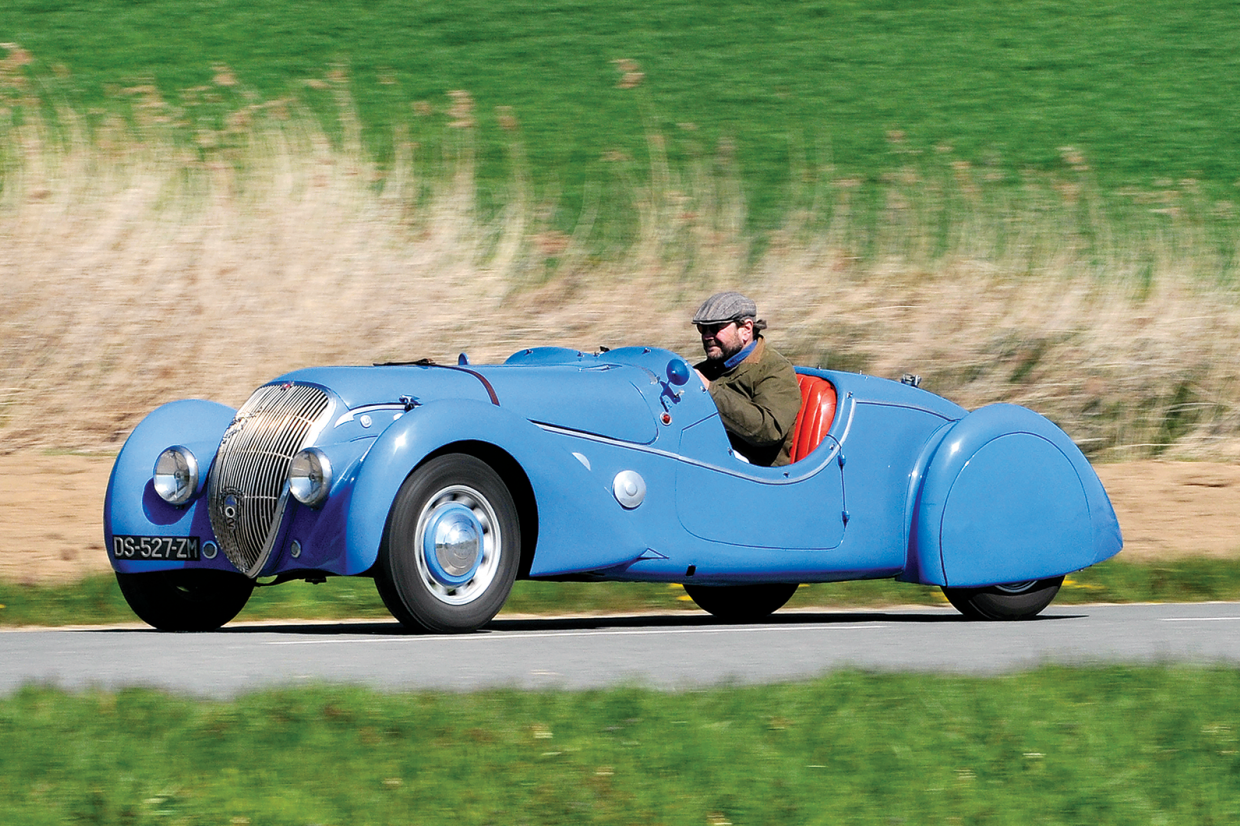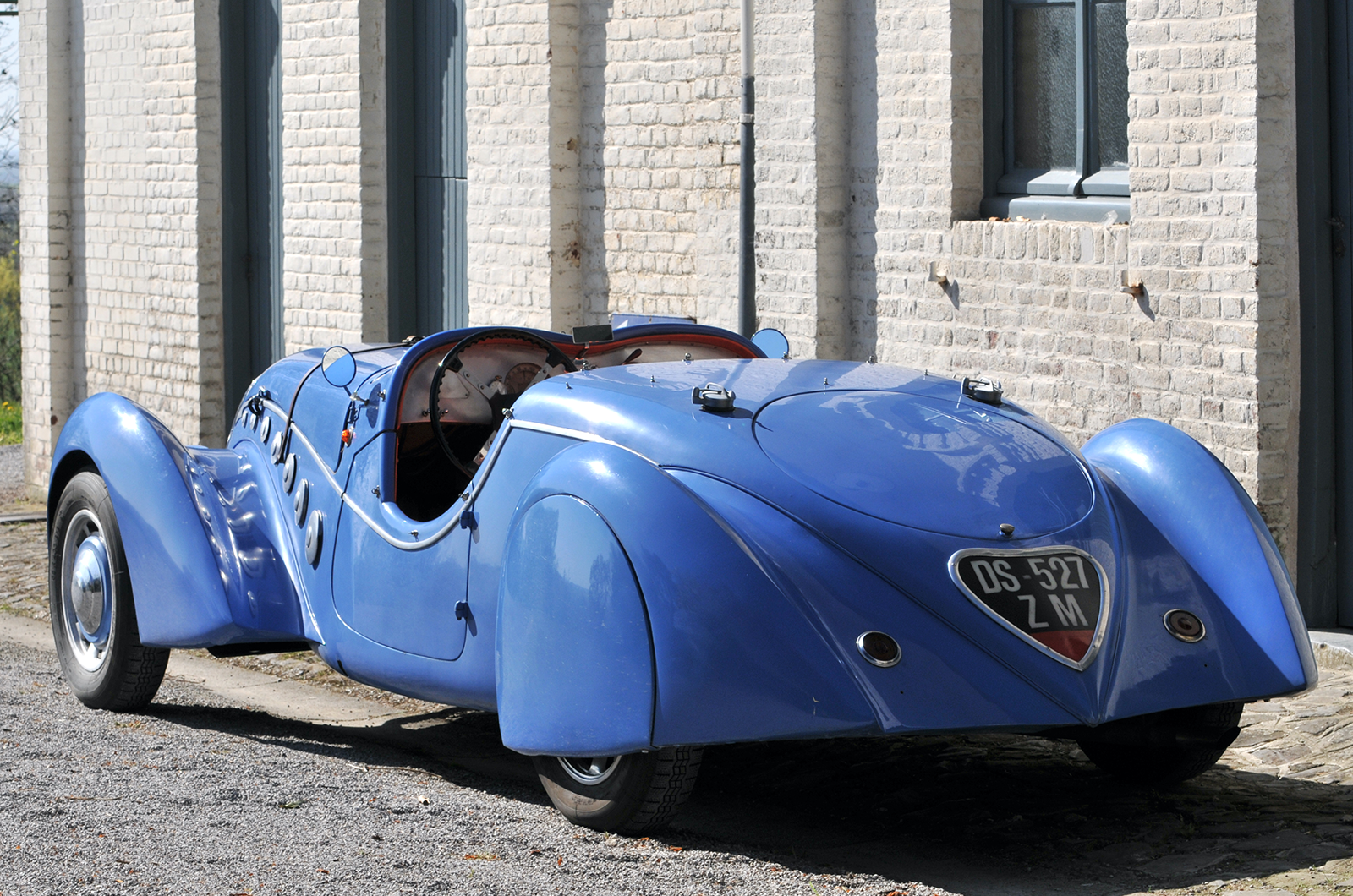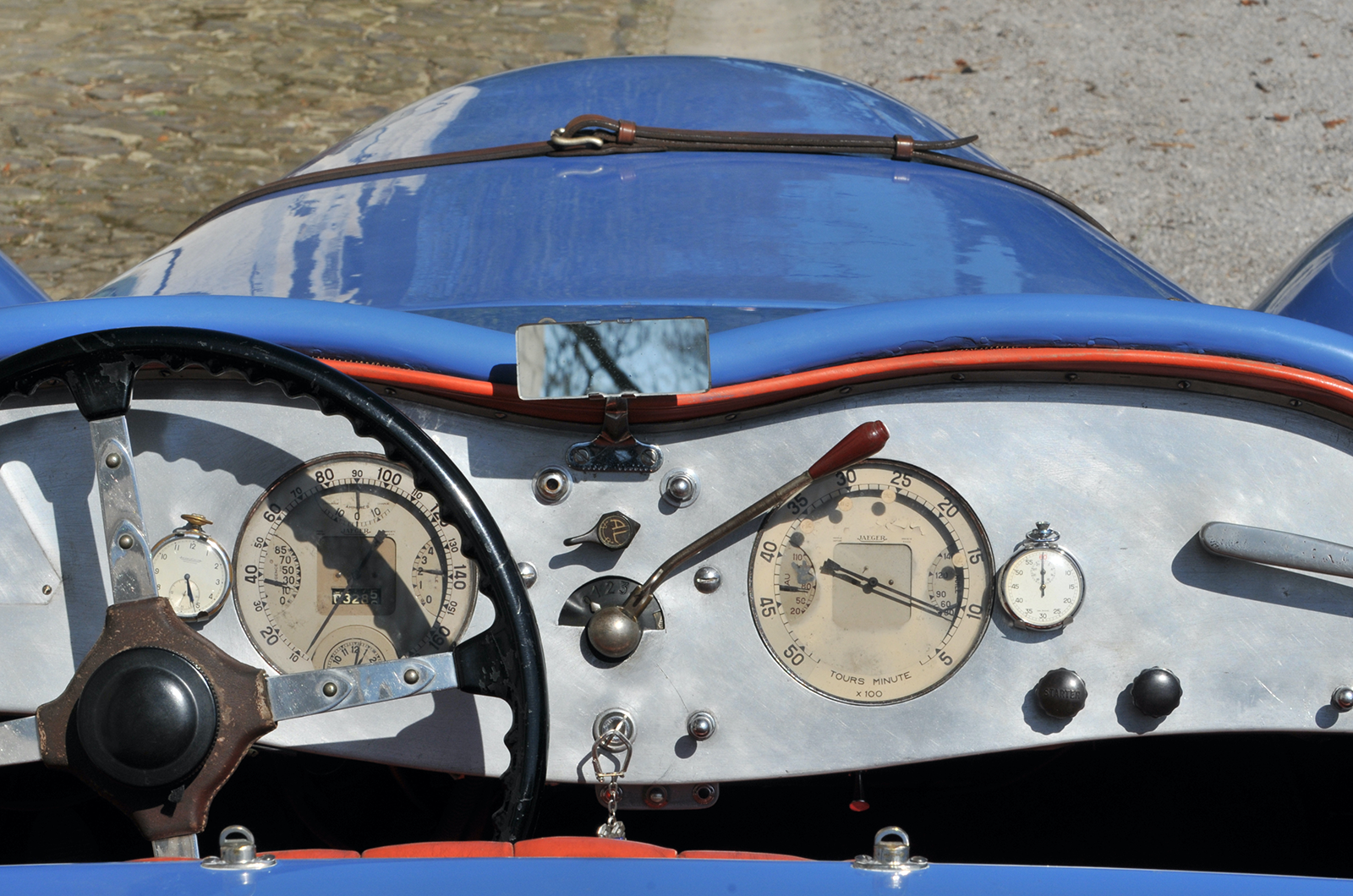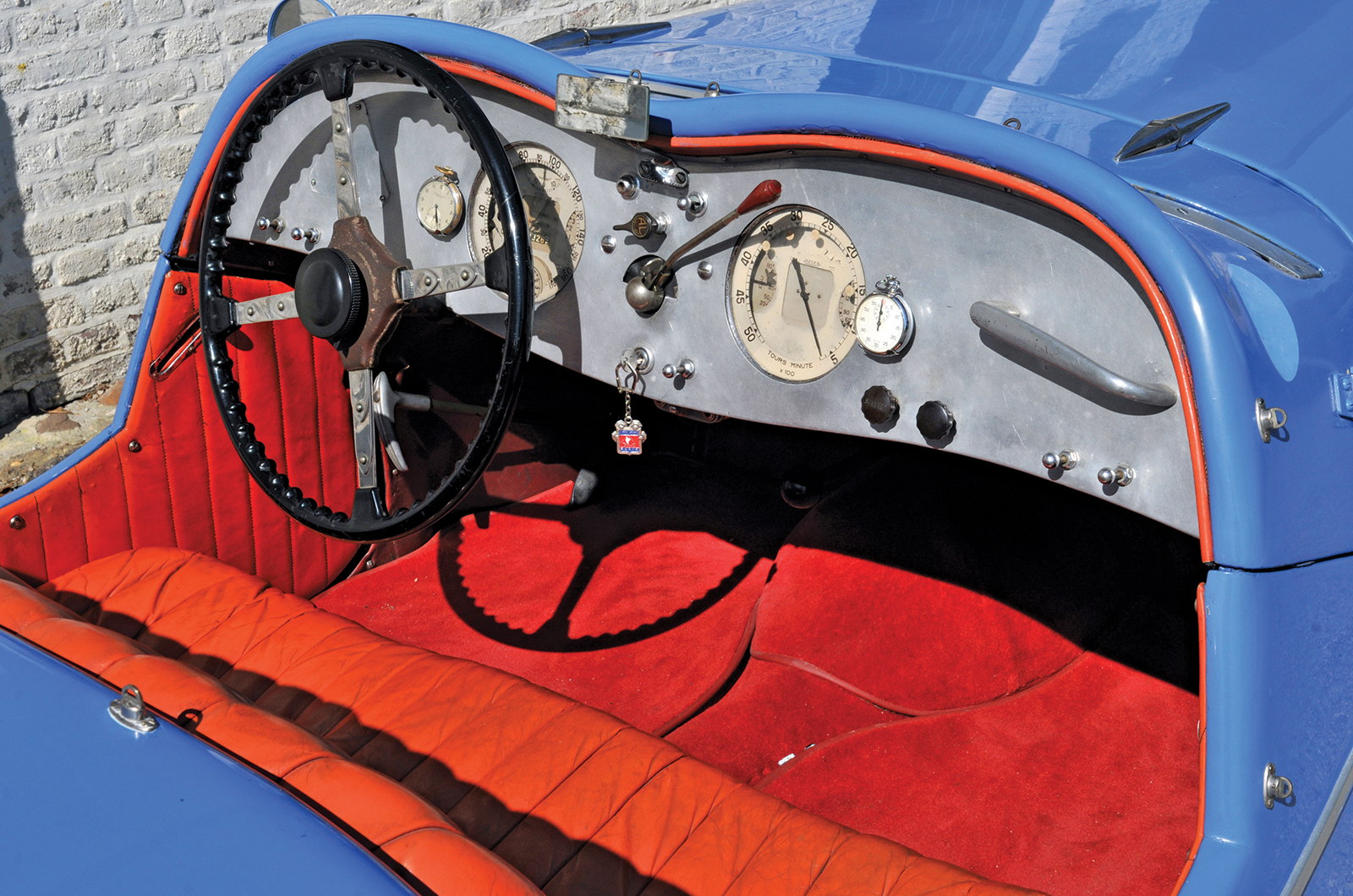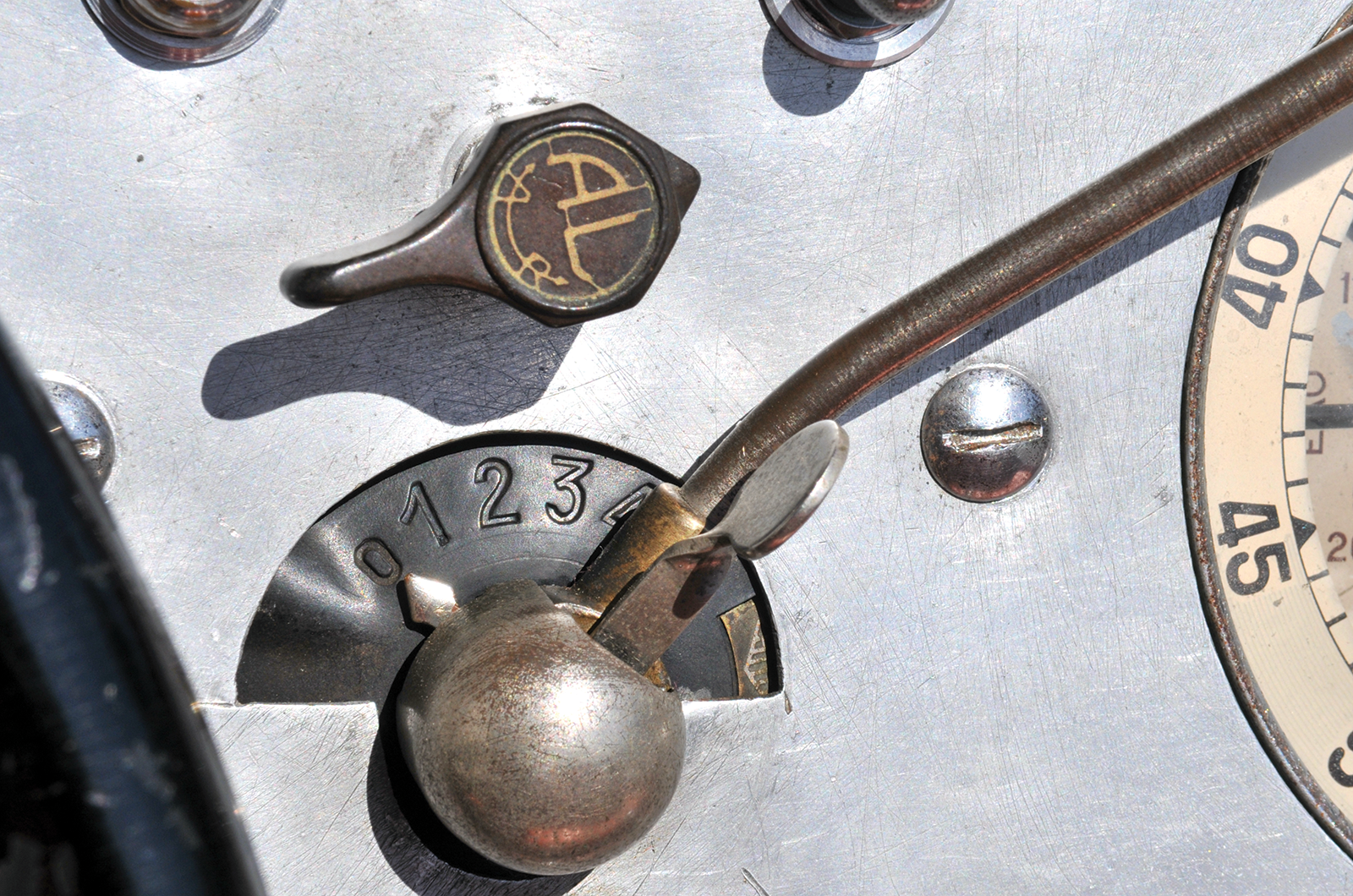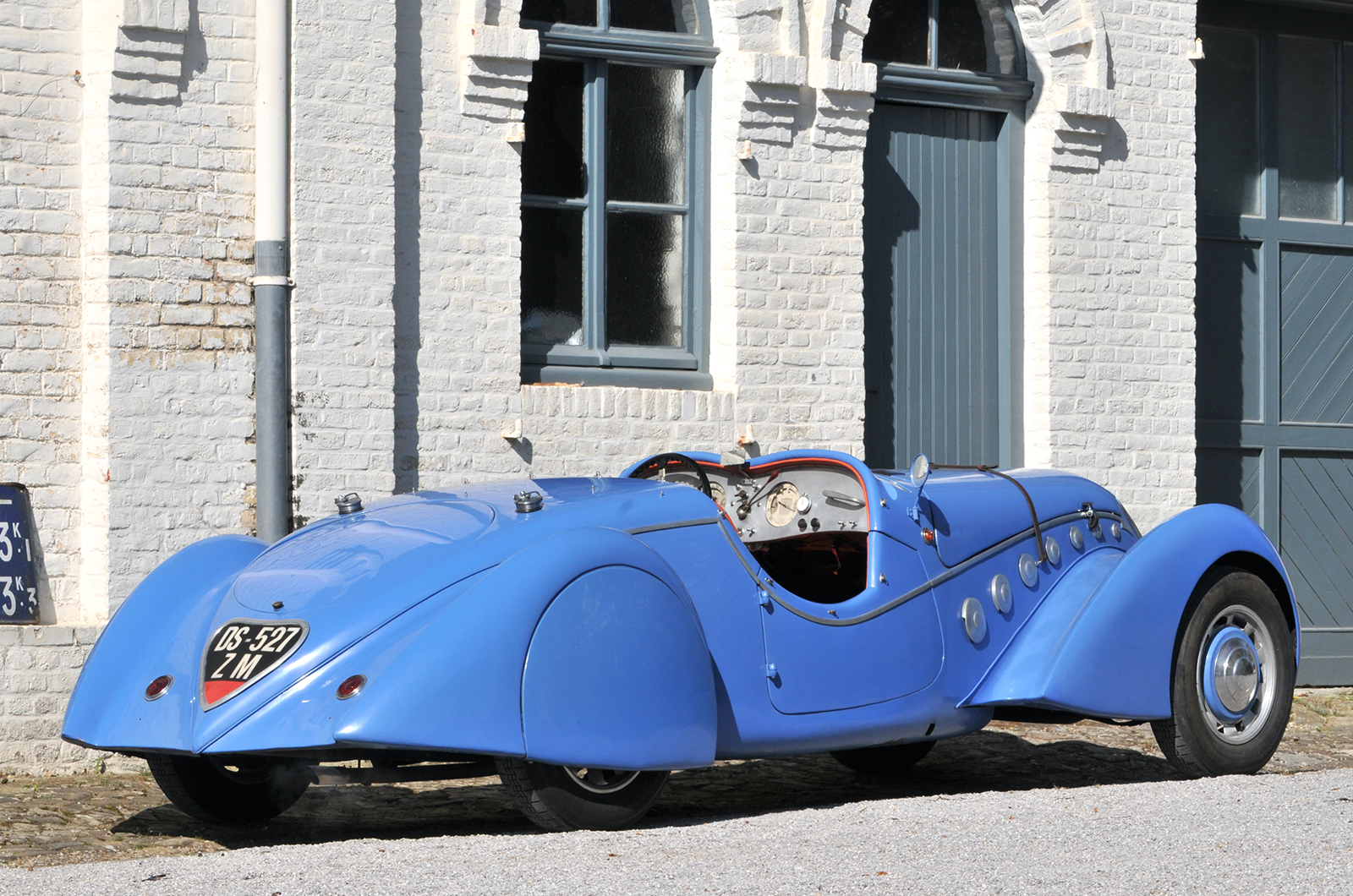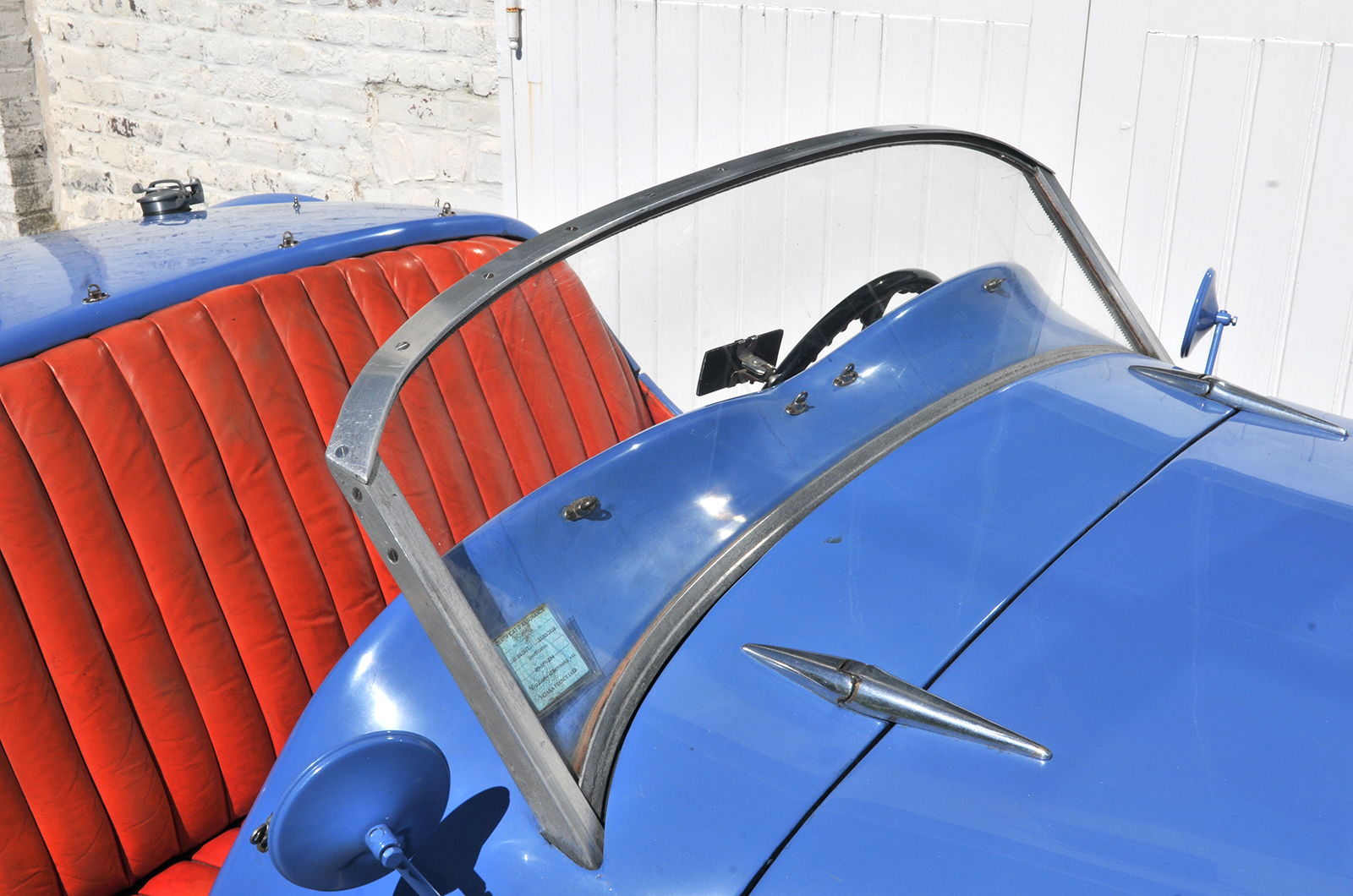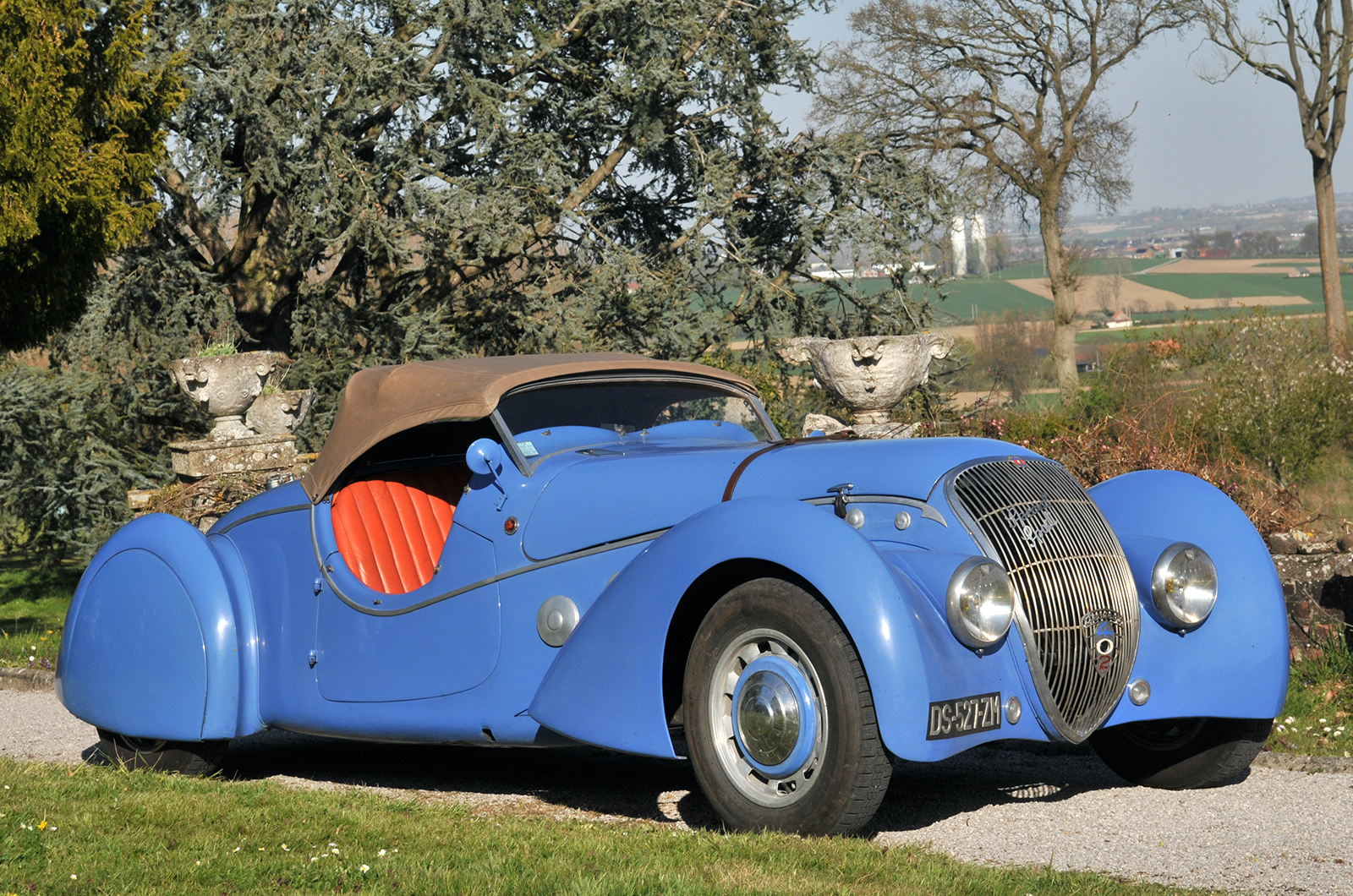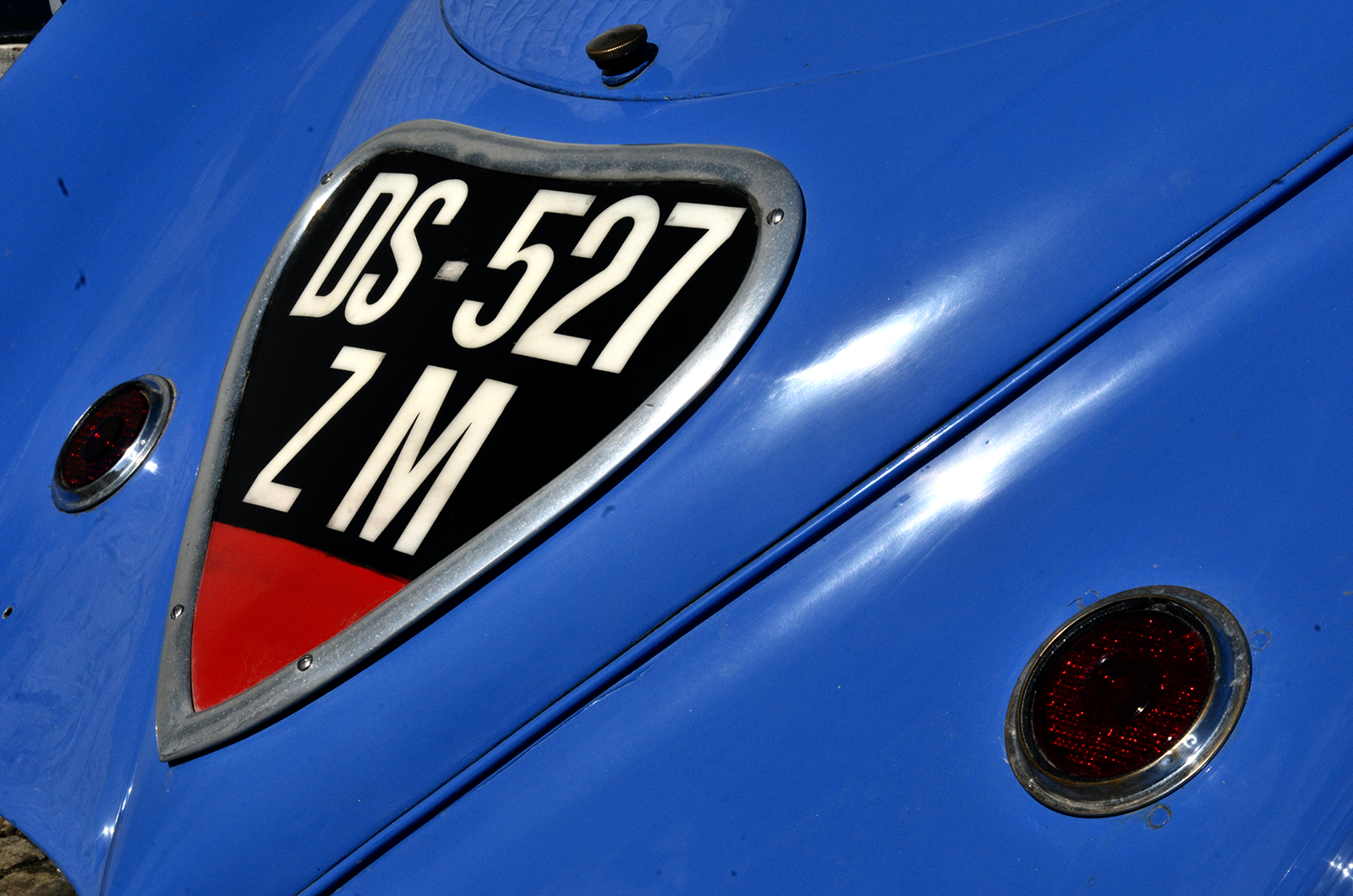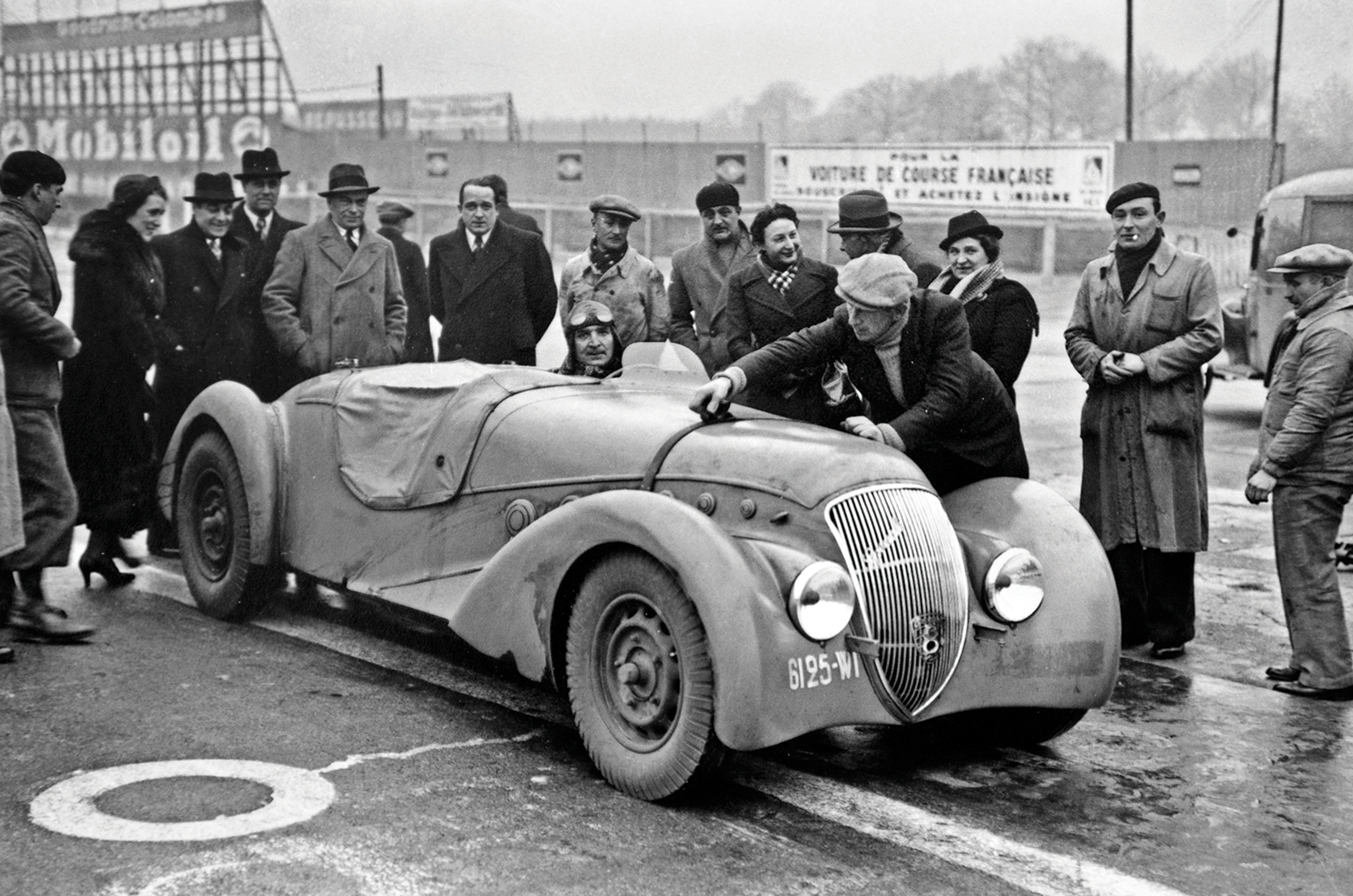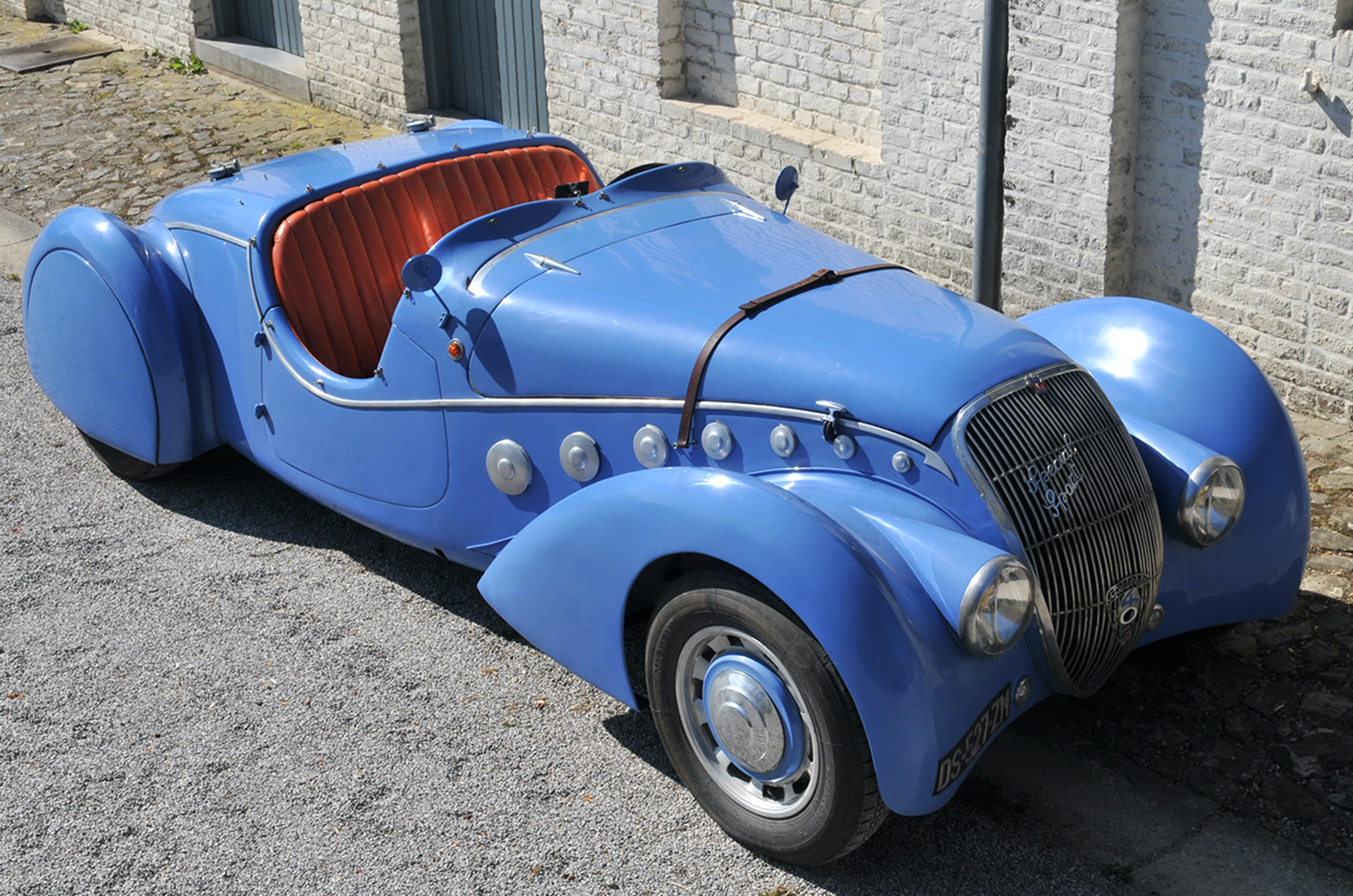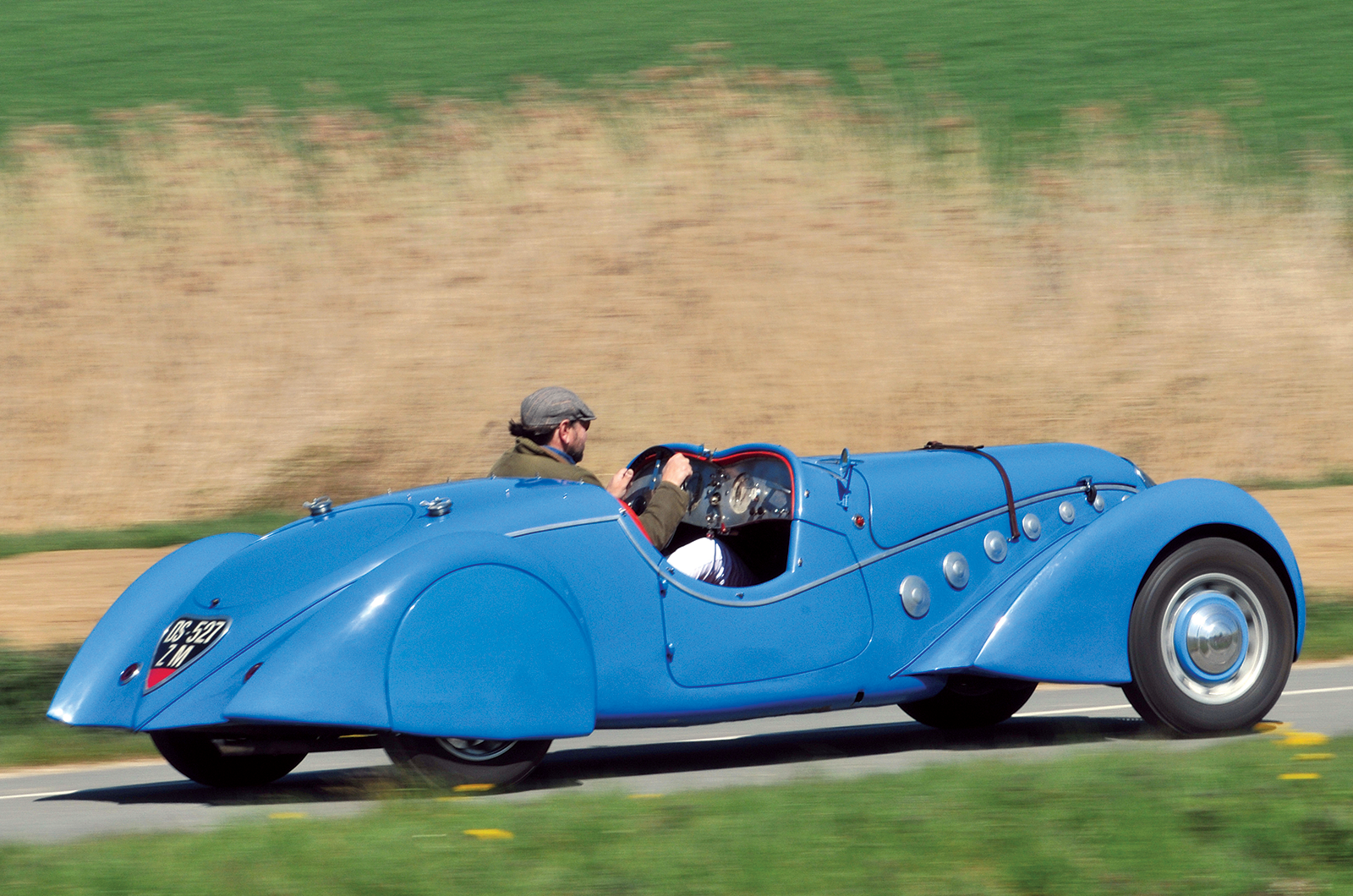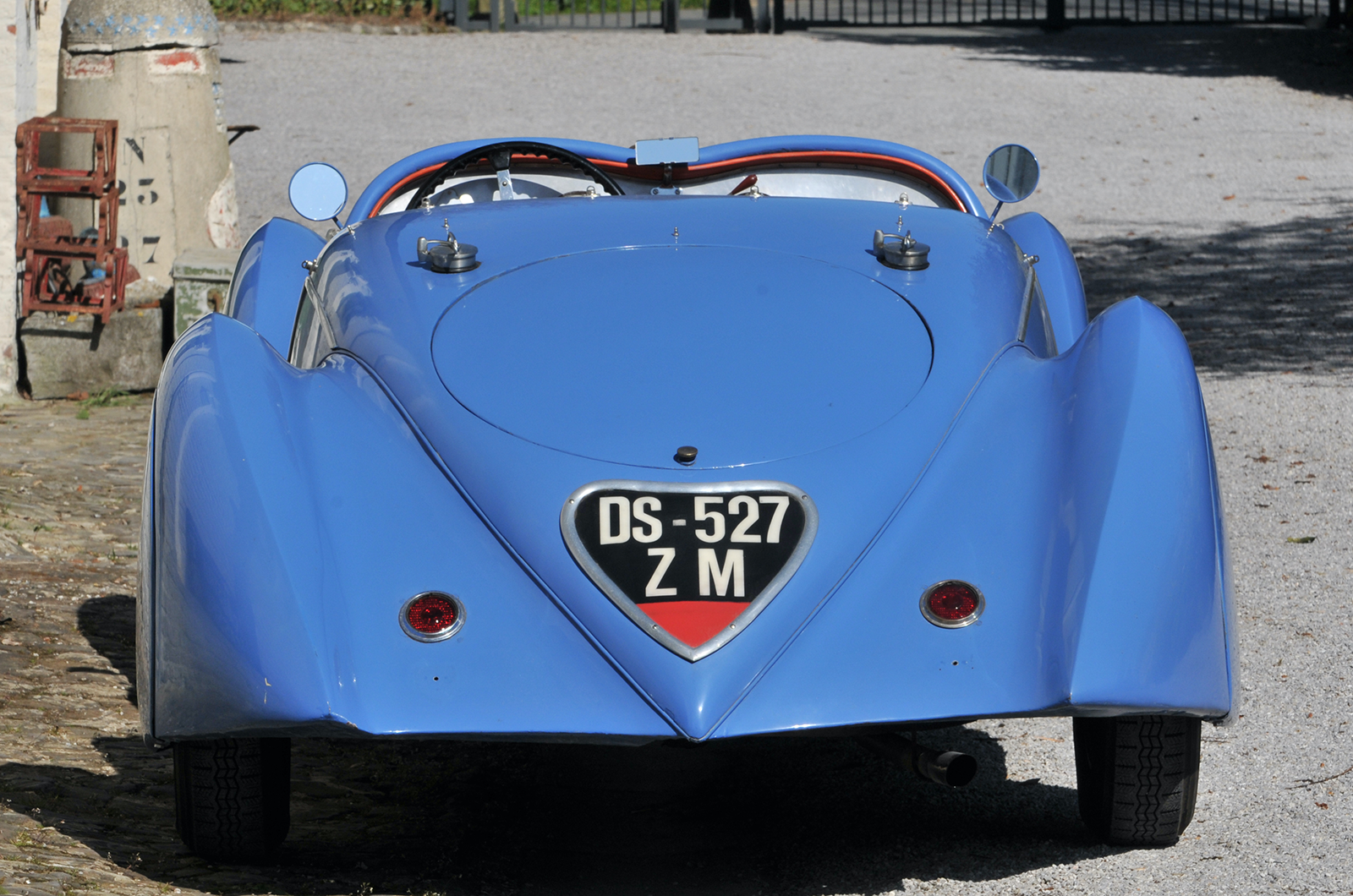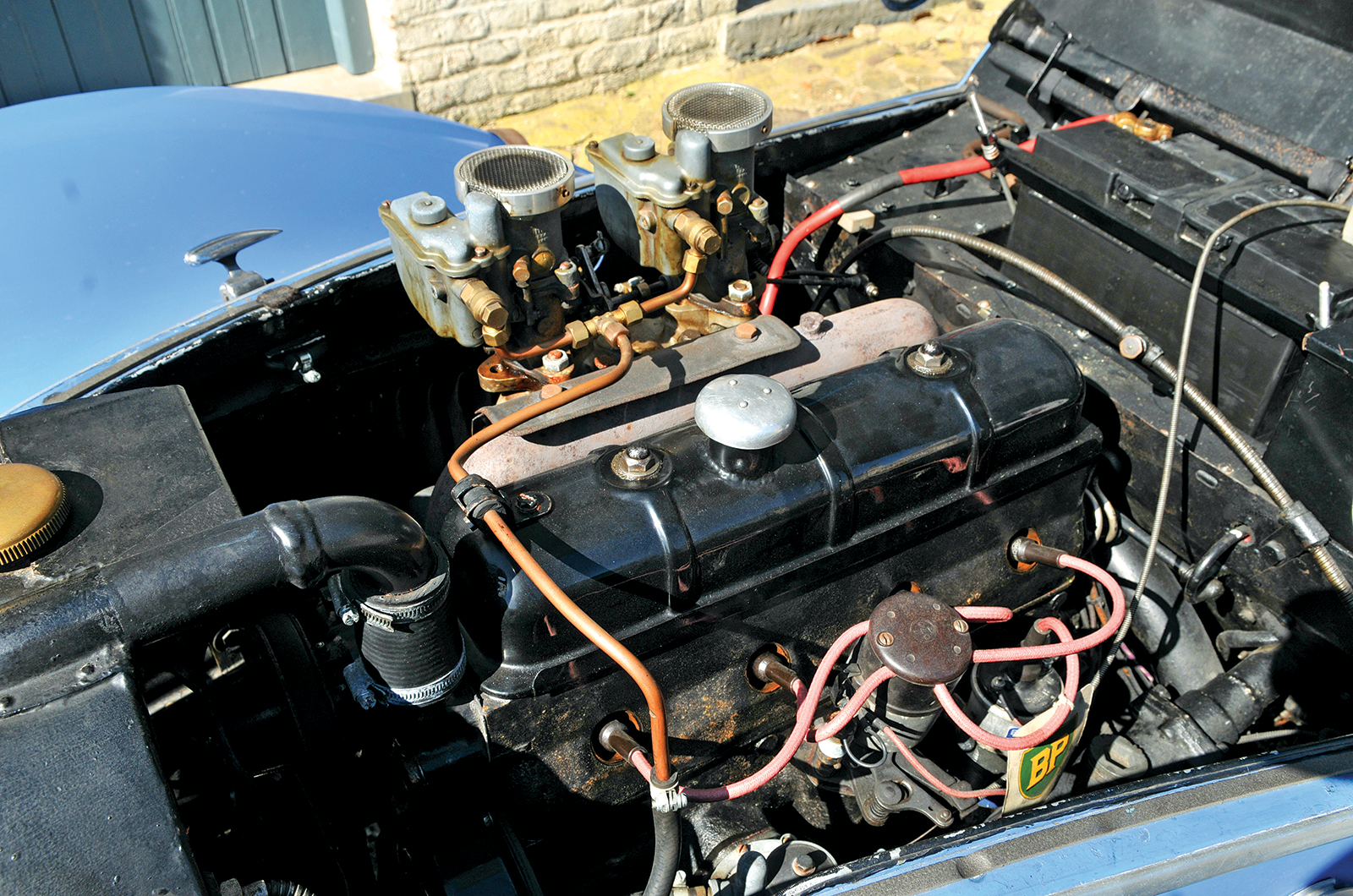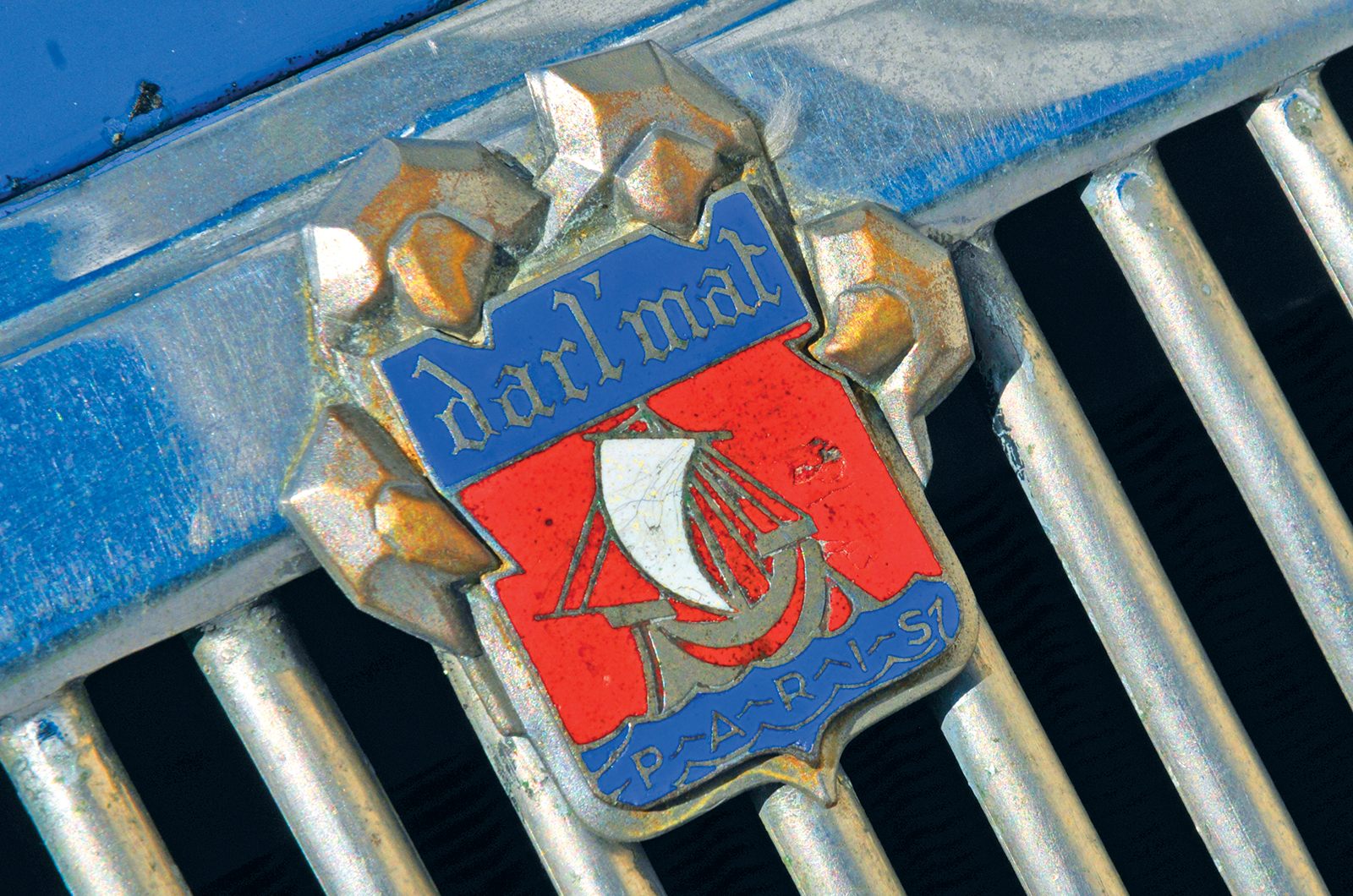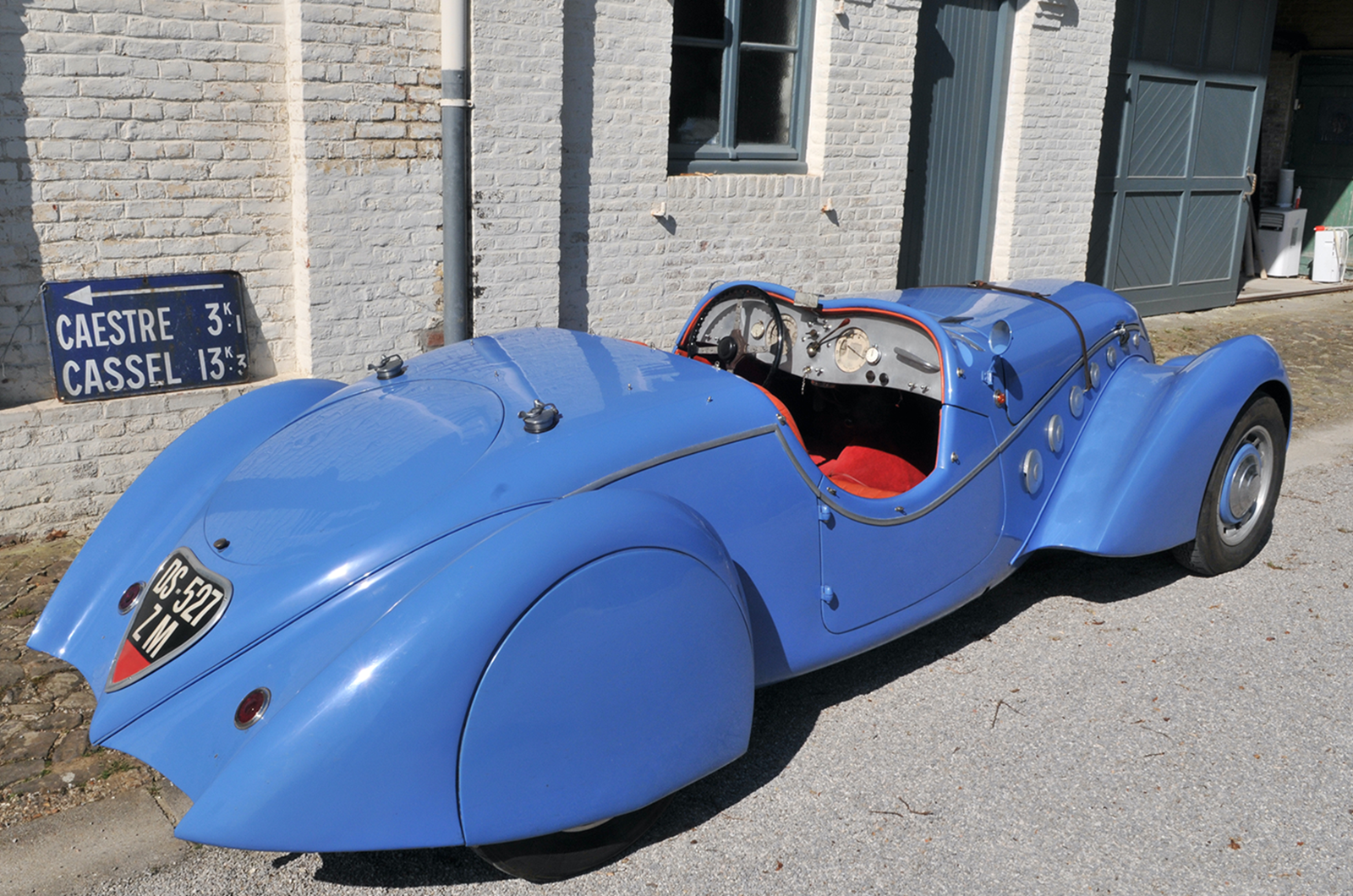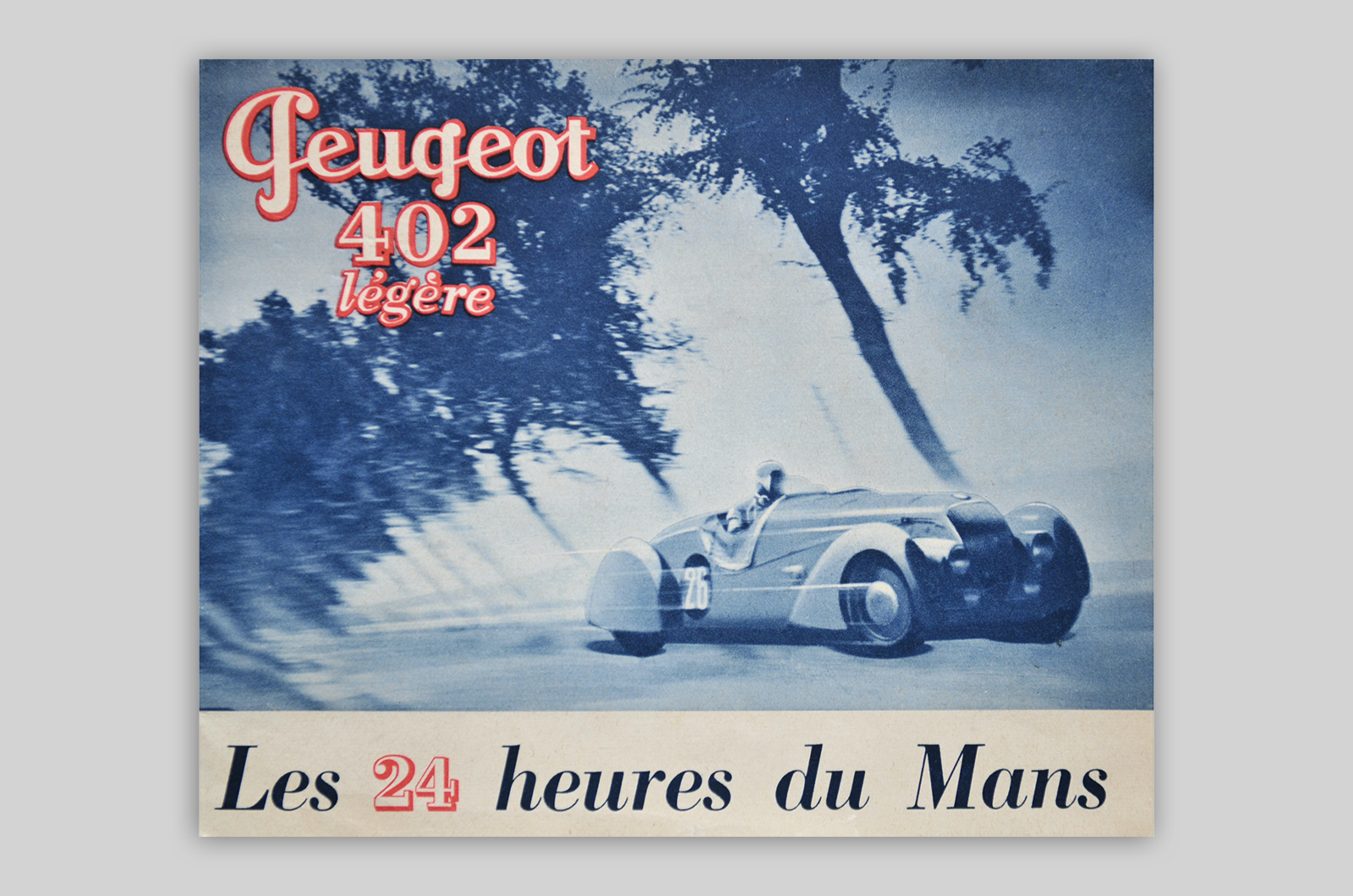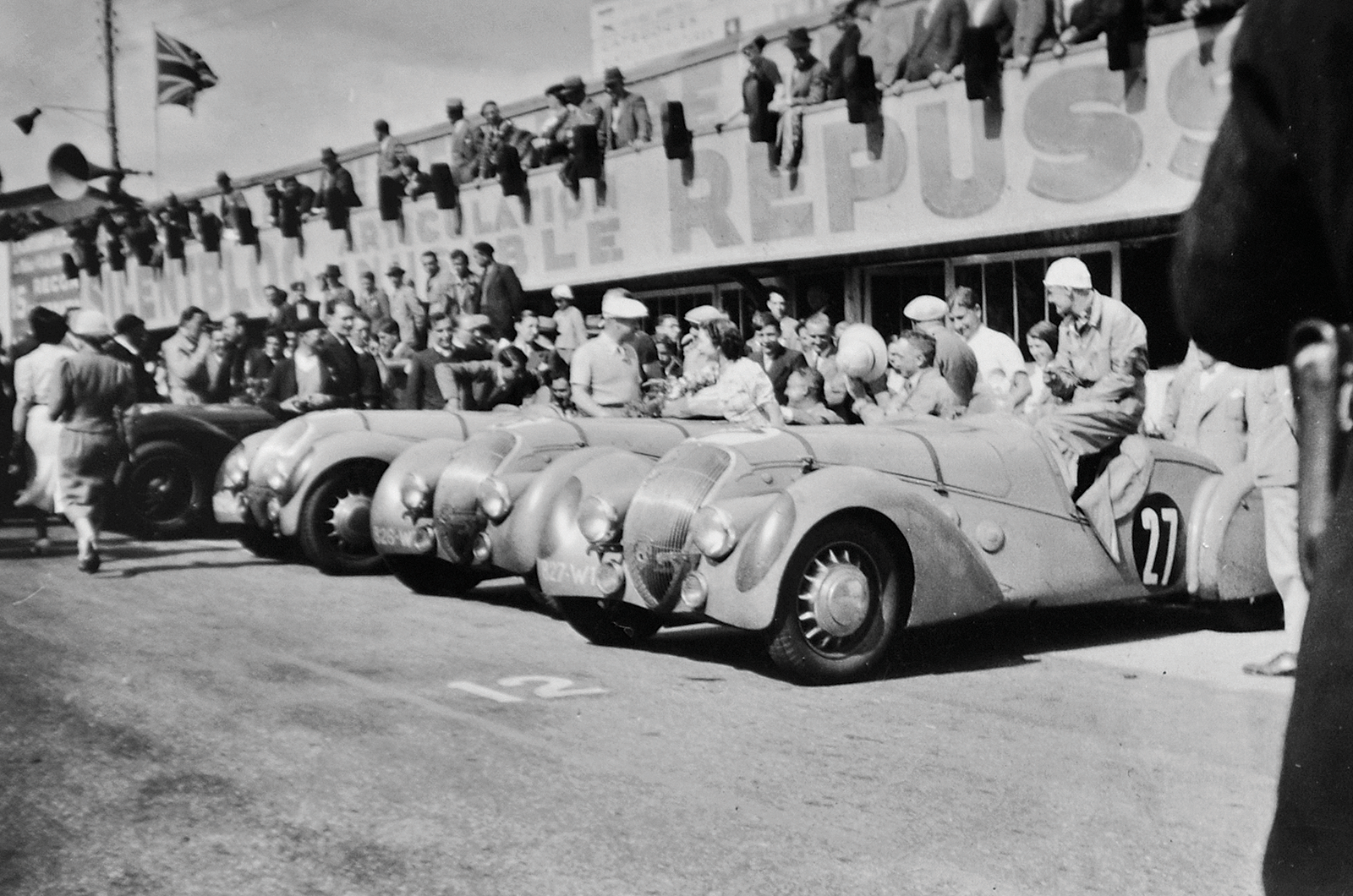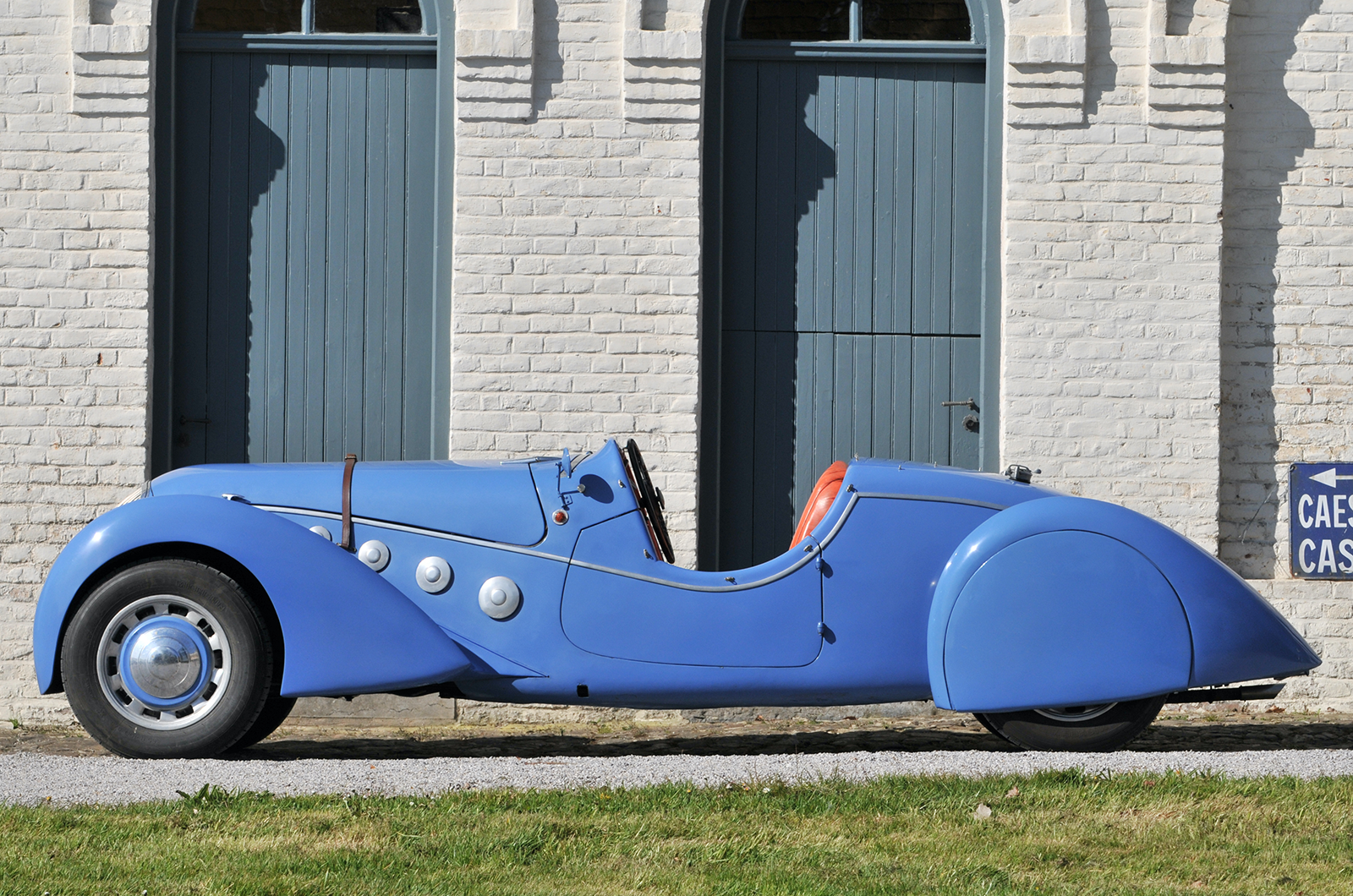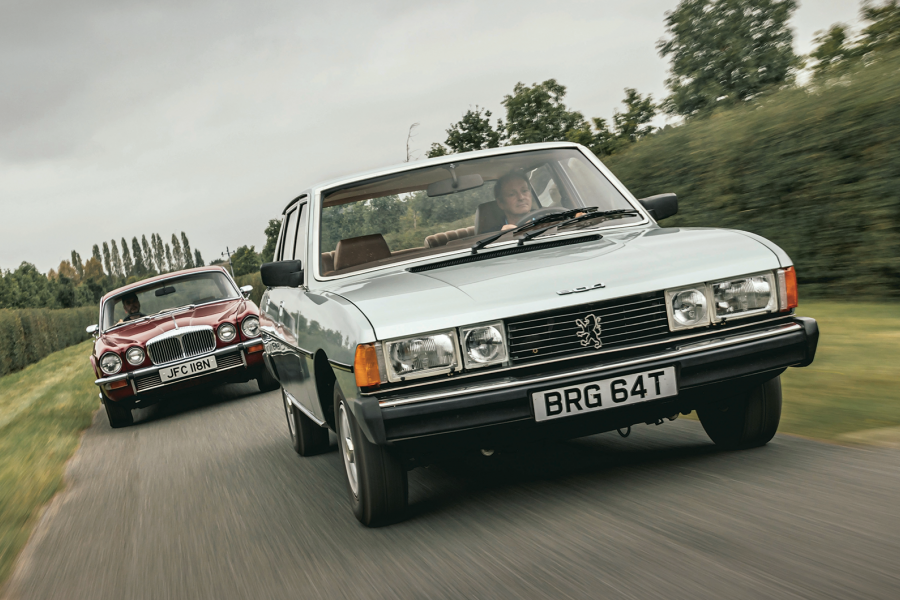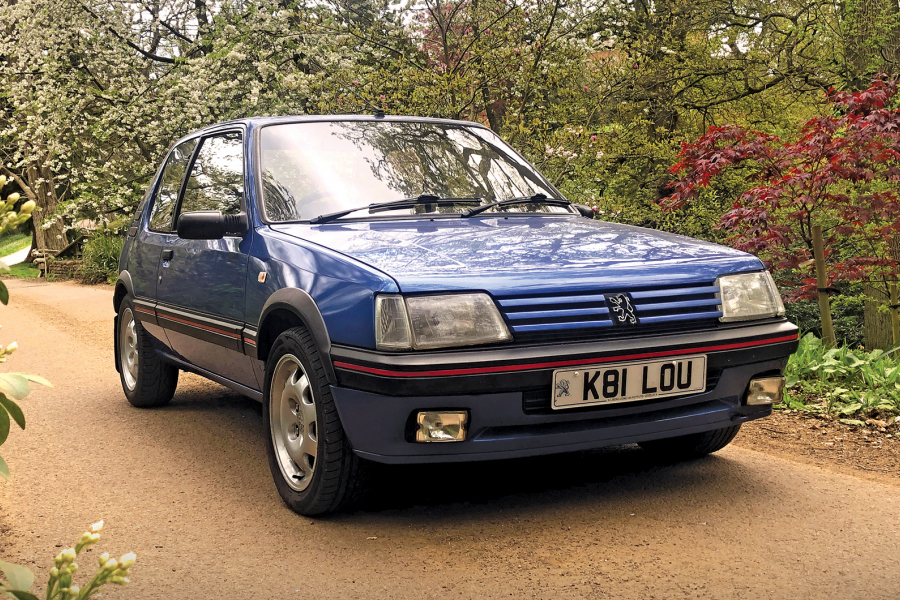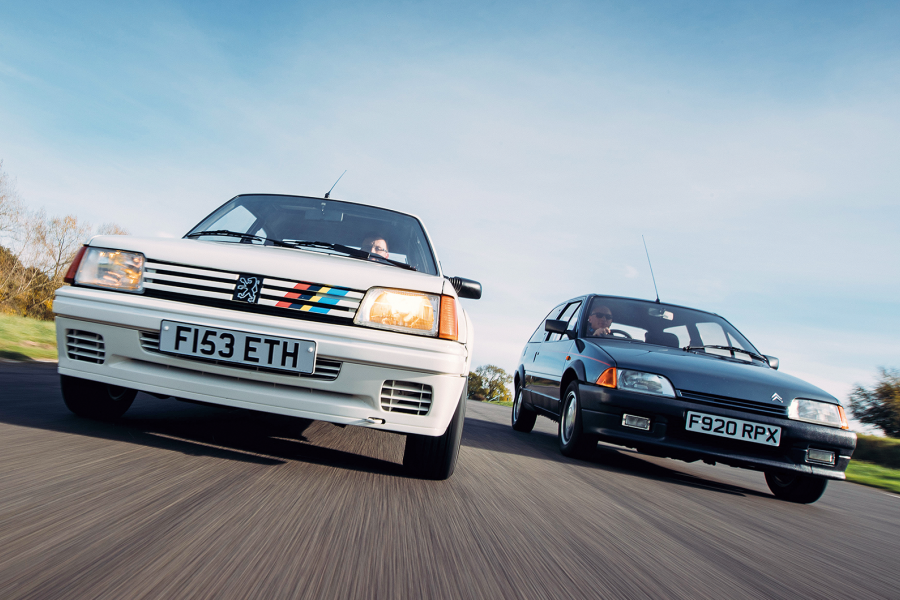This success confirmed the soundness of the project and led to a commercial launch, in January 1937, across the Peugeot network.
The production model differed from the Montlhéry prototype in only a few details, such as its doors and steel bodywork (except for certain elements, such as the aluminium bonnet, which varied depending on the car’s date of manufacture).
After the roadster, an elegant coupé version was offered from April 1937 then, in the autumn of that year, a more comfortable cabriolet with high doors, a fixed windscreen incorporating proper wipers and a soft-top.
At the rear, a round cover hides the Peugeot’s spare wheel
The model evolved from 302 to 402 with the appearance of the 402 Légère, which used the sports version’s combination of 302 chassis and 402 mechanicals.
The 302 and 402 DS were almost identical, but the Cotal transmission was more common on the latter, offered as an alternative to the basic model’s three-speed manual gearbox to create the DSE, for ‘Darl’mat Sport Electromagnetic’.
These performance models enabled Darl’mat to get into racing and realise his dream of competing at Le Mans.
After the war, in private hands, the cars took part in other events, such as the Liège-Rome-Liège rally and the Grand Prix de Saint-Cloud.
The two-litre ohv ‘four’ makes around 55bhp in standard trim, but was tuned to nearer 70bhp for Le Mans
On the strength of their looks alone the 302 and 402 DS also stood out in the many concours d’élégance that were so fashionable in the late ’30s.
But the story of these cars came to an end more quickly than expected: in ’38, the Peugeot range was updated and the 402 Légère gave way to the 402B Légère, which sounded the death knell for the 402 DS, the last of which left the workshop in June of that year.
The outbreak of war then suffocated any ongoing projects.
The whole Darl’mat adventure didn’t end there, however, because the enterprising dealer pursued his dreams of modifying, improving and record-setting after the war, albeit without a return to Le Mans.
The Darl’mat-engineered 402 Spécial Sport is an agile, entertaining and well-balanced car
Émile Darl’mat died in 1970, but his name survives to this day in several Peugeot dealerships.
Enthusiasts had to wait until 1991 to see the lion marque’s return to Le Mans, this time with all the resources of the factory behind it.
The 302 and 402 DS therefore represent important milestones in French motorsport, testifying to a time when a privateeer could successfully represent the colours of a major manufacturer.
Words: Serge Cordey
Images: Serge Cordey/Christophe Pund Archive
Thanks to: Christophe Pund, La Galerie des Damiers
‘This car is particularly well preserved, even if it has changed colour: there are traces of green on edges of the bodywork’
From streamlining pioneer to war hero
In 1918, designer Georges Paulin was severely affected by the war when his mother was killed in a bombing raid. He was only 16 years old.
Paulin started work as a dental technician but remained passionate about aerodynamics and design, to which he devoted more and more time.
He made a name for himself in 1932 with a patent for a retractable roof, which was adopted by Peugeot on its 301 Éclipse, bodied in the workshops of Marcel Pourtout.
Paulin designed several models, each of which was characterised by the quest for optimum aerodynamic streamlining (typically in order to compensate for a sometimes modest power output).
In 1937, the preparation by Pourtout and Paulin of a sublime Delage D8 for the Paris Salon attracted the attention of Walter Sleator, a Rolls-Royce and Bentley agent in France.
Sleator had been commissioned to produce aerodynamic bodywork for Andre Maris Embiricos, a Greek shipping magnate and banker, based on a 4¼-litre Bentley.
Georges Paulin presented a very personal style that could also be found on the Embiricos Bentley
They decided to call on Paulin, who built what is now called the ‘Bentley Embiricos’ (above) after having carried out scale-model tests in the Meudon wind tunnel, and the elegant streamlined bodywork is reminiscent of the Peugeot Spécial Sport.
This achievement encouraged the Rolls-Royce group to secure the services of Paulin, who in 1939 produced the astonishing Corniche saloon for the brand.
When WW2 broke out, Paulin became heavily involved in the French Resistance alongside coachbuilder Georges Kellner and in liaison with Sleator.
He transmitted information to the RAF to direct its bombardments on various factories, using a hidden transmitting station.
But in November 1941 several members of the network were arrested, including Paulin, who was tortured and then shot in March 1942.
Émile Darl’mat’s Le Mans adventures
Émile Darl’mat received Peugeot’s approval to race at Le Mans, however the company stopped short from offering official support for the race
When he ran the 302 DS prototype at Montlhéry in 1936, Émile Darl’mat’s mind was on the most prestigious endurance race in the world, the 24 Hours of Le Mans.
Thanks to the car’s good initial results he received the factory’s blessing and assistance, although Peugeot chose not to offer its support officially in order to avoid the consequences of a failure – but it would, of course, be happy to benefit from any success.
Darl’mat prepared three cars for 1937 (with a more powerful engine, aluminium body without doors, 120-litre tank, Alpax rims, bucket seats and aeroscreen), entered for Charles de Cortanze/Maurice Serre (car 25), Jean Pujol/Marcel Contet (26) and Daniel Porthault/Luis Rigal (27).
Numbers 25, 26 and 27 line up at Le Mans in 1937; the trio would go on to cross the finish line together
Fearing a breakdown, the factory recommended keeping a moderate average speed and giving priority to the result for the whole team rather than any individual performance.
Darl’mat acquiesced and the three cars crossed the line together (in seventh, eighth and 10th), leaving a streamlined Adler free to win the 1500-2000cc category.
This result remained a superb triumph of preparation and organisation, the credit for which went to Darl’mat. He received Peugeot’s praise, and the manufacturer went on to exploit the achievement in its advertising.
In 1938 Darl’mat decided to enter again, with more advanced engine preparation (and a light-alloy cylinder head) that came close to producing 90bhp at 4500rpm.
A Peugeot 302 DS finished fifth at Le Mans in 1938; the category was dominated by French marques
Three cars were entered: de Cortanze/Contet (24), Pujol/Rigal (25) and Serre/Porthault (26).
This time Darl’mat was determined to beat the Adlers, but both cars 25 and 26 retired early due to failed cylinder head gaskets, having been disturbed the day before the race.
Everything then rested on de Cortanze/Contet, who finished in a strong fifth place overall and took victory in the 1500-2000cc category, just ahead of the Adler.
The French domination was total, with Delahaye and Talbot occupying the first four places.
Factfile
Peugeot 402 Spécial Sport
- Sold/number built 1937-’38/105 (302 and 402 DS)
- Construction ‘Bloctube’ steel chassis, steel body with aluminium bonnet
- Engine all-iron, ohv 1991cc ‘four’, single or twin Zenith-Stromberg carburettors
- Max power 70bhp @ 4500rpm
- Max torque n/a
- Transmission three-speed manual or four-speed Cotal electromagnetic, RWD
- Suspension: front independent, by lower links, transverse leaf spring rear live axle, semi-elliptic leaf springs; lever-arm dampers f/r
- Steering worm and sector
- Brakes cable-operated Bendix drums
- Length 13ft 9½in (4200mm)
- Width 5ft 6in (1680mm)
- Height 3ft 7¼in (1100mm)
- Wheelbase 9ft 5in (2880mm)
- Weight 1654lb (750kg)
- 0-60mph n/a
- Top speed 100mph (est)
- Mpg n/a
- Price new Ffr32,033
- Price now £300-350,000*
*Prices correct at date of original publication
READ MORE
Peugeot 203 Spécial Darl’mat: France’s unlikeliest sports saloon?
Tackling the Mille Miglia in a Blower Bentley
On track in the unique DB created to win at Le Mans
